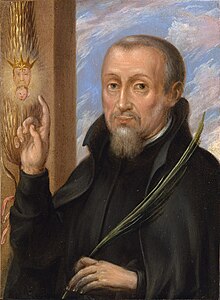The Rev. Henry Garnet | |
|---|---|
 A portrait of Garnet pointing to the bloodstained straw husk saved from the scene of his execution and said to bear his image | |
| Born | July 1555 Heanor, Derbyshire, England |
| Died | 3 May 1606 (aged 50) St Paul's, London |
| Cause of death | Execution |
| Occupation | Jesuit superior in England |
| Parent(s) | Brian Garnett, Alice Jay |
| Conviction(s) | Treason |
| Criminal penalty | Hanged, drawn and quartered |
Date apprehended | 27 January 1606 |
Henry Garnet SJ (July 1555 – 3 May 1606), sometimes Henry Garnett, was an English Jesuit priest executed for high treason, based solely on having had advanced knowledge of the 1605 Gunpowder Plot and having refused to violate the Seal of the Confessional by notifying the authorities. Born in Heanor, Derbyshire, he was educated in Nottingham and later at Winchester College before he moved to London in 1571 to work for a publisher. There he professed an interest in legal studies and in 1575, he travelled to the continent and joined the Society of Jesus. He was ordained in Rome some time around 1582.
In 1586 Garnet returned to England as part of the Jesuit mission, soon succeeding Father William Weston as Jesuit superior, following the latter's capture by the English authorities. Garnet established a secret press, which lasted until late 1588, and in 1594 he interceded in the Wisbech Stirs, a dispute between secular and regular clergy. Fr. Garnet preferred nonviolent resistance to the religious persecution Catholics faced in England. He accordingly approved of the disclosure by Catholic priests of the existence of the 1603 Bye Plot, and repeatedly exhorted English Catholics not to plot violent regime change.
In summer 1605 Garnet met with Robert Catesby, a member of the English nobility who, unknown to him, planned to assassinate the Protestant King James I. The existence of Catesby's Gunpowder Plot was revealed to Fr. Garnet by Father Oswald Tesimond on 24 July 1605, but as the information was received under the seal of the confessional, canon law prevented Frs. Garnet and Tesimond from telling the authorities under penalty of immediate excommunication. Instead, Fr. Garnet pleaded with Catesby to cancel what he was plotting. Fr. Garnet also wrote to his superiors in Rome, urging them to order English Catholics not to use violence.
When the plot failed Garnet went into hiding, but he was eventually arrested on 27 January 1606. He was taken to London and interrogated by the Privy Council, whose members included John Popham, Edward Coke and Robert Cecil, 1st Earl of Salisbury. Imprisoned in the Tower of London, his conversations with fellow prisoner Edward Oldcorne were monitored by eavesdroppers, and his letters to friends such as Anne Vaux were intercepted. His conviction, announced at the end of his trial on 28 March 1606, was a foregone conclusion. Criticised for his use of equivocation, which Coke called "open and broad lying and forswearing", and condemned for not warning the authorities of what Catesby planned, he was sentenced to be hanged, drawn and quartered. He was executed on 3 May 1606.